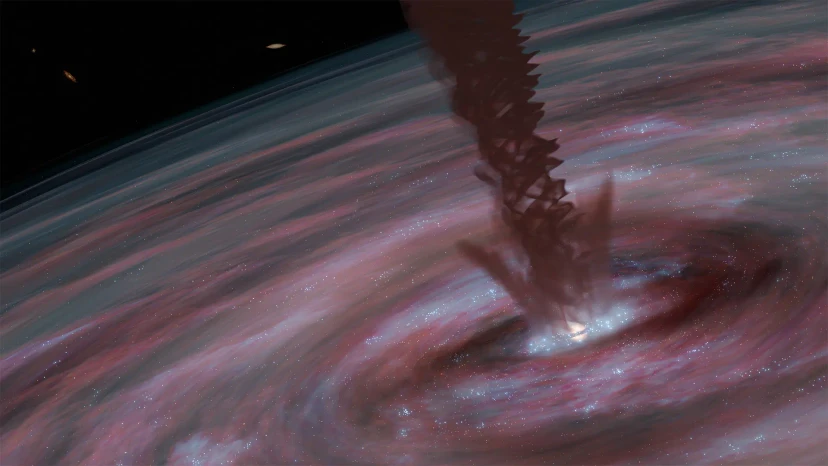Reviewed by Lexie CornerJun 21 2024
An international team of astronomers, including researchers from Chalmers University of Technology, has discovered a rotating, magnetic wind in the galaxy ESO320-G030. Using the ALMA telescope, they found that this wind, driven by magnetic fields, feeds the supermassive black hole and resembles the processes involved in star formation. This research was published in the journal Astronomy & Astrophysics.
 Artist’s impression: The spiraling rising from the galaxy ESO320-G030, with colored lines and arrows showing the motions of the gas traced by light from molecules of hydrogen cyanide and seen with the ALMA telescope (blue indicated motion towards us and red away). Image Credit: M. D. Gorski/Aaron M. Geller, Northwestern University, CIERA, the Center for Interdisciplinary Exploration and Research in Astrophysics.
Artist’s impression: The spiraling rising from the galaxy ESO320-G030, with colored lines and arrows showing the motions of the gas traced by light from molecules of hydrogen cyanide and seen with the ALMA telescope (blue indicated motion towards us and red away). Image Credit: M. D. Gorski/Aaron M. Geller, Northwestern University, CIERA, the Center for Interdisciplinary Exploration and Research in Astrophysics.
Astronomers worldwide have unsolved questions about supermassive black holes, chief among them being “How do they grow so big?” An international team of astronomers, including scientists from Chalmers University of Technology in Sweden, recently found a strong spinning magnetic wind.
They believe this wind assists in the growth of a galaxy's central supermassive black hole. The swirling wind observed in the nearby galaxy ESO320-G030, made visible by the Alma telescope, indicates that similar processes are involved in the formation of stars and the growth of black holes.
The center of most galaxies, including the Milky Way, is home to a supermassive black hole. Astronomers have long wondered how these astronomically large objects become as heavy as millions or billions of stars.
Since this galaxy is very luminous in the infrared, telescopes can resolve striking details in its center. We wanted to measure light from molecules carried by winds from the galaxy’s core, hoping to trace how the winds are launched by a growing, or soon-to-be-growing, supermassive black hole. By using ALMA, we were able to study light from behind thick layers of dust and gas.
Susanne Aalto, Professor, Radio Astronomy, Chalmers University of Technology
Molecules Revealed the Wind
To zero in on dense gas as close as possible to the central black hole, the scientists studied light from molecules of hydrogen cyanide (HCN). Using the Doppler effect, ALMA's capacity to capture minute details and track gas movements allowed them to find patterns that might indicate the existence of a rotating, magnetized wind.
The recently found wind adds a process that can feed and aid in the growth of the supermassive black hole, whereas other winds and jets in the center of galaxies push material away from the black hole.
We can see how the winds form a spiraling structure, billowing out from the galaxy’s center. When we measured the rotation, mass, and velocity of the material flowing outwards, we were surprised to find that we could rule out many explanations for the power of the wind, star formation for example. Instead, the flow outwards may be powered by the inflow of gas and seems to be held together by magnetic fields.
Susanne Aalto, Professor, Radio Astronomy, Chalmers University of Technology
Scientists believe the rotating magnetic wind aids the black hole's growth.
The material travels around the black hole before falling in, similar to water swirling around a drain. As matter approaches the black hole, it gathers in a chaotic, spinning disk. Magnetic fields form and intensify there.
The magnetic fields help lift matter away from the galaxy, creating the spiraling wind. When matter is lost to this wind, the spinning disk slows down, and more matter can enter the black hole, turning a trickle into a stream.
Similar to How Baby Stars are Born
According to Mark Gorski, the process by which this occurs is remarkably similar to a much smaller-scale environment in space, the gas and dust swirls that precede the formation of new stars and planets.
It is well-established that stars in the first stages of their evolution grow with the help of rotating winds – accelerated by magnetic fields, just like the wind in this galaxy. Our observations show that supermassive black holes and tiny stars can grow by similar processes but on very different scales.
Mark Gorski, Northwestern University
Is there a chance that this finding may help unravel the supermassive black hole growth puzzle? Mark Gorski, Susanne Aalto, and associates hope to investigate additional galaxies in the future because they might have spiral outflows buried in their centers.
Mark Gorski asked, “Far from all questions about this process are answered. In our observations, we see clear evidence of a rotating wind that helps regulate the growth of the galaxy’s central black hole. Now that we know what to look for, the next step is to find out how common a phenomenon this is. And if this is a stage which all galaxies with supermassive black holes go through, what happens to them next?”
Journal Reference:
Gorski, M. D., et al. (2024) A spectacular galactic scale magnetohydrodynamic powered wind in ESO 320-G030. Astronomy & Astrophysics. doi.org/10.1051/0004-6361/202348821.